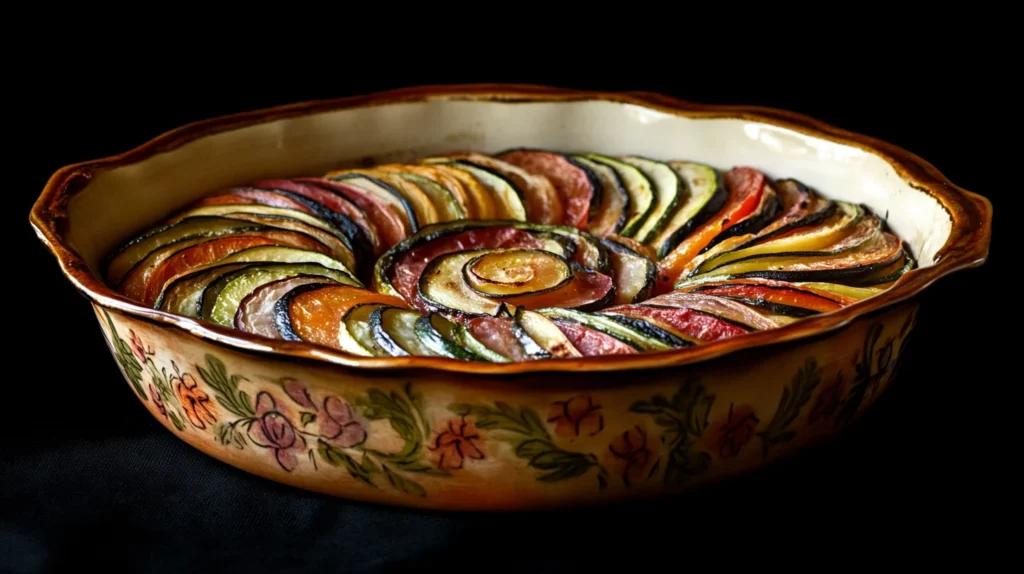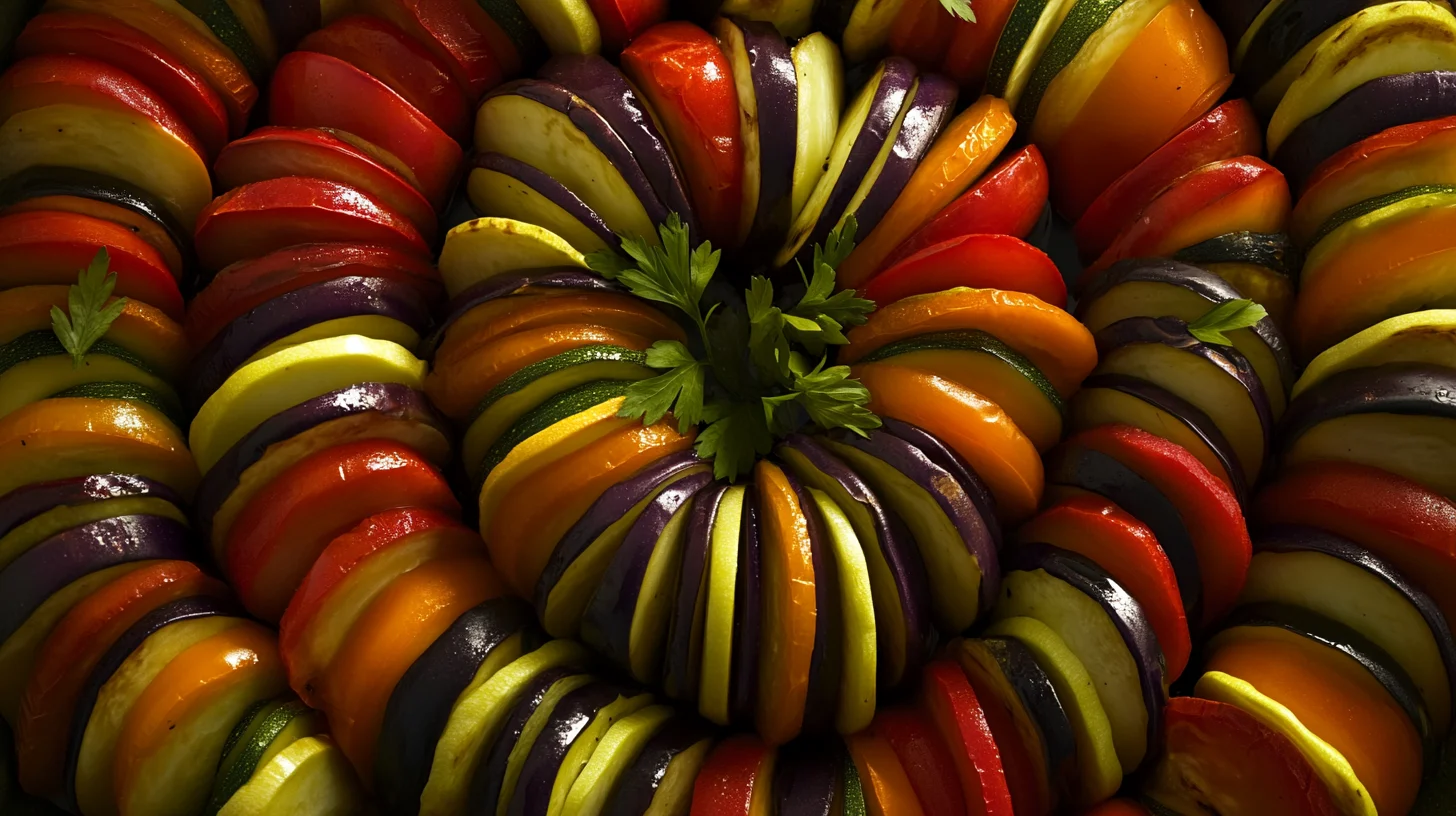Ratatouille is a dish that is easy to make, full of flavor, and loved by many. It brings together fresh, colorful vegetables like zucchini, eggplant, and tomatoes, cooked in olive oil with herbs. This simple recipe comes from Provence, a region in southern France known for its Mediterranean cuisine. Ratatouille is not only healthy and tasty but also versatile—it can be served as a side dish, a main course, or even as a topping.
In this guide, you’ll learn everything you need to know to prepare the perfect Ratatouille. Whether you are cooking for family or friends, this dish will impress everyone with its vibrant flavors and beautiful presentation.
What is Ratatouille?
Ratatouille is a traditional French vegetable stew made with simple, fresh ingredients. The main vegetables used are eggplant, zucchini, tomatoes, and bell peppers. These are cooked with onions, garlic, olive oil, and herbs like thyme and basil. The dish is naturally vegan, vegetarian, and gluten-free, so it suits almost every diet.
What makes Ratatouille so special is its flexibility. You can cook it on the stovetop for a rustic feel, bake it in the oven for a more elegant look, or even use a slow cooker for convenience. If you enjoy Mediterranean-style cooking, you might also want to try this Stuffed Mushrooms Recipe, which pairs perfectly with Ratatouille.
Ingredients for Ratatouille
To make Ratatouille, you don’t need fancy ingredients. Here’s a simple list of what you’ll need:
- Eggplant: Adds a creamy and hearty texture.
- Zucchini: Brings a mild, slightly sweet taste.
- Bell Peppers: Add a smoky flavor and bright colors.
- Tomatoes: Form the base, making the dish rich and tangy.
- Onions and Garlic: Enhance the flavor with a savory aroma.
- Fresh Herbs: Use thyme, basil, and parsley for a Mediterranean touch.
- Olive Oil: A good-quality extra virgin olive oil is best for rich flavor.
- Seasonings: Add salt, black pepper, and a pinch of red pepper flakes for a little spice.
If you want to experiment with more flavors, you might enjoy this Seafood Boil Sauce Recipe, which complements the freshness of Ratatouille.
Preparing the Vegetables
Preparation is an important step to make your Ratatouille look and taste amazing. Follow these simple steps:
- Wash and Dry: Start by washing all your vegetables thoroughly. Pat them dry with a clean towel. Dry vegetables cook better and won’t make the dish watery.
- Slice Evenly: Slice the eggplant, zucchini, and tomatoes into thin, even rounds. This helps them cook evenly and gives the dish a neat appearance.
- Chop Aromatics: Dice the onions and garlic finely. This spreads their flavor throughout the dish.
- Salt the Eggplant: Sprinkle salt on the eggplant slices and let them sit for about 10 minutes. This removes bitterness and reduces moisture. Rinse and pat dry before using.
Taking time to prepare your vegetables properly ensures your Ratatouille will look great and taste delicious.

How to Make Ratatouille
There are several ways to cook Ratatouille. You can choose the method that works best for you.
Traditional Stovetop Method
This method is easy and gives the dish a rustic feel.
- Heat olive oil in a large pot over medium heat.
- Add the diced onions and garlic and cook until they are soft and fragrant.
- Layer the sliced vegetables in the pot, starting with zucchini, then eggplant, tomatoes, and bell peppers.
- Sprinkle herbs and seasonings between each layer.
- Cover the pot and let the vegetables simmer on low heat for 30-40 minutes, stirring occasionally.
Oven-Baked Ratatouille
This version is perfect if you want a beautiful presentation.
- Preheat your oven to 375°F.
- Arrange the sliced vegetables in a baking dish in a spiral pattern. Alternate the slices for a colorful design.
- Drizzle olive oil over the vegetables and sprinkle with thyme and basil.
- Cover with foil and bake for 40 minutes. Remove the foil and bake for another 10 minutes to caramelize the tops.
Slow Cooker Ratatouille
This method is great if you want a hands-free option.
- Layer the vegetables in your slow cooker, starting with onions and garlic.
- Add olive oil, fresh herbs, and seasonings to each layer.
- Cook on low for 6-8 hours or on high for 3-4 hours. The slow cooking enhances the flavors and makes the vegetables tender.
Serving Ideas for Ratatouille
Ratatouille can be served in many ways, depending on what you like.
- As a Side Dish: Pair it with roasted chicken, grilled fish, or beef.
- As a Main Course: Serve it over rice, couscous, or quinoa for a filling meal.
- Creative Leftovers:
- Use as a topping for crusty bread to make bruschetta.
- Add it to an omelet or frittata for a hearty breakfast.
- Use it as a pizza topping for a unique twist.
If you want to try a low-carb option, pair it with Low-Carb Gluten-Free Bread. This bread complements the rich flavors of Ratatouille perfectly.
For an added twist, you can explore recipes like this Seafood Boil Sauce Recipe, which pairs beautifully with the fresh flavors of Ratatouille.
Frequently Asked Questions
What is the secret of a good Ratatouille?
The secret lies in using fresh, high-quality vegetables and layering them carefully for even cooking. Slow cooking allows the flavors to blend beautifully, while proper seasoning with herbs and olive oil enhances the dish.
What is made in Ratatouille?
Ratatouille is made with vegetables like zucchini, eggplant, tomatoes, and bell peppers, along with onions, garlic, olive oil, and fresh herbs. These ingredients are cooked together to create a flavorful and healthy dish.
What do you traditionally eat with Ratatouille?
Ratatouille pairs well with roasted meats, grilled fish, or crusty bread. It can also be served over rice, quinoa, or couscous for a hearty meal.
Why is it called Ratatouille?
The word “ratatouille” comes from the French verb touiller, which means “to stir.” This name reflects the method of stirring the vegetables while cooking.
What makes Ratatouille different from Caponata?
Ratatouille is a French dish of slow-cooked vegetables, while Caponata is a Sicilian recipe that includes eggplant, olives, capers, and vinegar for a tangy flavor.
How can I keep my Ratatouille from being watery?
Dry your vegetables after washing, avoid overcrowding the pot or baking dish, and salt the eggplant to reduce moisture.
Can I freeze Ratatouille?
Yes, Ratatouille freezes well. Let it cool completely, then store it in an airtight container. It will last up to three months in the freezer. Thaw it overnight in the fridge and reheat gently.
Should I serve Ratatouille hot or cold?
Ratatouille can be served warm, at room temperature, or chilled. It tastes even better the next day as the flavors deepen.
What temperature should I bake Ratatouille at?
Bake Ratatouille at 375°F for even cooking and caramelized vegetables that add depth to the flavor.
Can I add protein to Ratatouille?
Yes, adding grilled chicken, shrimp, or chickpeas can make the dish more filling while keeping it healthy and flavorful.
Understanding the Importance of Nutritional Values for Health and Longevity
Monitoring the nutritional content of your meals, such as the ingredients in Ratatouille, plays a crucial role in maintaining overall health and promoting a longer life. Here’s why understanding these values is important:
- Calories:
- Monitoring calorie intake ensures you maintain a healthy weight, which reduces the risk of chronic diseases like diabetes, heart disease, and obesity. The low-calorie nature of Ratatouille ingredients makes it a great choice for weight management.
- Protein:
- Protein is essential for repairing tissues, building muscles, and supporting immune function. Ingredients like eggplant and zucchini contribute to your daily protein needs, especially in plant-based diets.
- Carbohydrates:
- Carbs are the body’s primary energy source. Including vegetables with complex carbohydrates, like onions and tomatoes, provides energy without causing blood sugar spikes.
- Fiber:
- Fiber promotes healthy digestion, prevents constipation, and supports heart health by lowering cholesterol. High-fiber vegetables like eggplant and bell peppers contribute to a balanced diet and improved gut health.
- Fats:
- While many ingredients in Ratatouille are naturally low in fat, the inclusion of olive oil adds healthy fats that support brain function and reduce inflammation. These fats are particularly beneficial for cardiovascular health.
- Key Nutrients (Vitamins and Minerals):
- Vitamins like A, C, and E, along with antioxidants found in tomatoes, peppers, and garlic, help combat free radicals, which are linked to aging and chronic diseases.
- Minerals like potassium in zucchini and manganese in garlic support blood pressure regulation and bone health.
By choosing dishes like Ratatouille, which are packed with nutrient-dense ingredients, you can enjoy meals that are not only flavorful but also incredibly beneficial for your health. Incorporating meals with a variety of vegetables into your diet ensures a balance of essential nutrients, helping you live longer, maintain energy, and prevent illnesses.
Understanding and monitoring these nutritional aspects fosters informed eating habits that lead to a healthier and more vibrant life.
Conclusion
Ratatouille is a delightful and versatile dish that showcases the beauty of fresh vegetables and Mediterranean flavors. Whether you prepare it using the stovetop, oven-baked, or slow-cooker method, this recipe is simple to make and consistently satisfying. Its vibrant colors and rich flavors make it a standout addition to any table, whether as a side dish or a main course.
For a complete Mediterranean-inspired meal, pair Ratatouille with dishes like our Stuffed Mushrooms Recipe or serve it alongside a tangy Seafood Boil Sauce. Additionally, explore resources like the Mediterranean Diet Foundation to learn more about the health benefits of Mediterranean cuisine or visit France.fr for a deeper dive into French culinary traditions.
Try this recipe today and bring a taste of Provence into your kitchen. With just a few simple ingredients, you can create a dish that’s both nutritious and unforgettable. Bon appétit!

